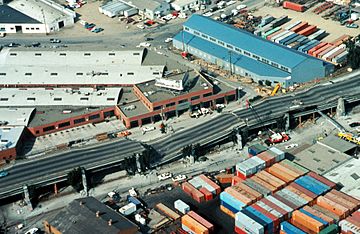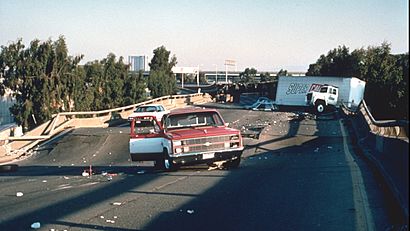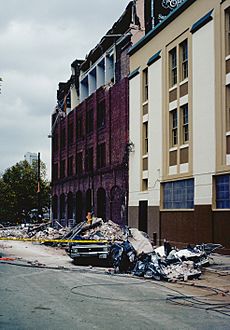1989 Loma Prieta earthquake facts for kids

Image of collapsed Cypress freeway structure in Oakland, California
|
|
| UTC time | 1989-10-18 00:04:14 |
|---|---|
| ISC event | 389808 |
| USGS-ANSS | ComCat |
| Local date | October 17, 1989 |
| Local time | 17:04:15 PDT |
| Duration | 8–15 seconds |
| Magnitude | 6.9 Mw, 7.2 Ms |
| Depth | 19 km (12 mi) |
| Epicenter | 37°02′N 121°53′W / 37.04°N 121.88°W |
| Type | Oblique-slip reverse |
| Areas affected | Central Coast (California) San Francisco Bay Area United States |
| Total damage | $5.6–6 billion (equivalent to $13.2–14.2 billion today) |
| Max. intensity | IX (Violent) |
| Peak acceleration | 0.65 g (at epicenter) |
| Tsunami | Yes |
| Landslides | 1,000–4,000 |
| Foreshocks | 5.3 ML June 27, 1988 5.4 ML August 8, 1989 |
| Casualties | 63 killed, 3,757 injured |
The 1989 Loma Prieta earthquake occurred on California's Central Coast on October 17 at 5:04 p.m. local time. The shock was centered in The Forest of Nisene Marks State Park in Santa Cruz County, approximately 10 mi (16 km) northeast of Santa Cruz on a section of the San Andreas Fault System and was named for the nearby Loma Prieta Peak in the Santa Cruz Mountains. With an Mw magnitude of 6.9 and a maximum Modified Mercalli intensity of IX (Violent), the shock was responsible for 63 deaths and 3,757 injuries. The Loma Prieta segment of the San Andreas Fault System had been relatively inactive since the 1906 San Francisco earthquake (to the degree that it was designated a seismic gap) until two moderate foreshocks occurred in June 1988 and again in August 1989.
Damage was heavy in Santa Cruz County and less so to the south in Monterey County, but effects extended well to the north into the San Francisco Bay Area, both on the San Francisco Peninsula and across the bay in Oakland. No surface faulting occurred, though many other ground failures and landslides were present, especially in the Summit area of the Santa Cruz Mountains. Liquefaction was also a significant issue, especially in the heavily damaged Marina District of San Francisco, but its effects were also seen in the East Bay, and near the shore of Monterey Bay, where a non-destructive tsunami was also observed.
Because it happened during a national live broadcast of the 1989 World Series, the annual championship series of Major League Baseball, taking place between Bay Area teams San Francisco Giants and the Oakland Athletics, it is sometimes referred to as the "World Series earthquake", with the championship games of the year being referred to as the "Earthquake Series". Rush-hour traffic on the Bay Area freeways was lighter than normal because the game, being played at Candlestick Park in San Francisco, was about to begin, and this may have prevented a larger loss of life, as several of the Bay Area's major transportation structures suffered catastrophic failures. The collapse of a section of the double-deck Nimitz Freeway in Oakland was the site of the largest number of casualties for the event, but the collapse of man-made structures and other related accidents contributed to casualties occurring in San Francisco, Los Altos, and Santa Cruz.
Contents
Earthquake
The Loma Prieta earthquake was named for Loma Prieta Peak in the Santa Cruz Mountains, which lies just to the east of the mainshock epicenter. The duration of the heaviest shaking in the Santa Cruz Mountains was about 15 seconds. At sites with rocky terrain, the duration was shorter and the shaking was much less intense.
Ground effects
The majority of landslides occurred to the southwest of the epicenter, especially along road cuts in the Santa Cruz Mountains and in the Summit Road area, but also along the bluffs of the Pacific Coast, and as far north as the Marin Peninsula. Highway 17 was blocked for several weeks by a large slide and one person was killed by a rockfall along the coast. Other ground effects included downslope movement, slumps, and ground cracks.
Injuries and fatalities
Fifty-seven of the deaths were directly caused by the earthquake; six further fatalities were ruled to have been caused indirectly. In addition, there were 3,757 injuries as a result of the earthquake, 400 of which were serious. The highest number of deaths, 42, occurred in Oakland because of the collapse of the Cypress Street Viaduct on the Nimitz Freeway (Interstate 880), where the upper level of a double-deck portion of the freeway collapsed, crushing the cars on the lower level, and causing crashes on the upper level. One 50-foot (15 m) section of the San Francisco–Oakland Bay Bridge also collapsed, leading to a single fatality, Anamafi Moala, a 23-year-old woman. Three people were killed in the collapse of buildings along the Pacific Garden Mall in Santa Cruz, and five people were killed in the collapse of a brick wall on Bluxome Street in San Francisco.
When the earthquake hit, the third game of the 1989 World Series baseball championship was about to begin. Because of the unusual circumstance that both of the World Series teams (the San Francisco Giants and Oakland Athletics) were based in the affected area, many people had left work early or were staying late to participate in after work group viewings and parties. As a consequence the normally crowded freeways contained unusually light traffic. If traffic had been normal for a Tuesday rush hour, injuries and deaths would certainly have been higher. The initial media reports failed to take into account the game's effect on traffic and initially estimated the death toll at 300, a number that was corrected to 63 in the days after the earthquake.
Magnetic disturbances
After the earthquake occurred, a group led by Antony C. Fraser-Smith of Stanford University reported that before the eventthe had noticed disturbances in background magnetic field noise, about 4.5 miles (7 km) from the epicenter. Increases of noise apparently started a few days before the earthquake, with noise in the range 0.01–0.5 Hz rising to exceptionally high levels about three hours before the earthquake. The Fraser-Smith et al. report remains one of the most frequently cited claims of a specific earthquake precursor; more recent studies have cast doubt on the connection, attributing the signals to either unrelated magnetic disturbance or, even more simply, to sensor-system malfunction.
Damage
The earthquake caused severe damage in some very specific locations in the Bay Area, most notably on unstable soil in San Francisco and Oakland. Oakland City Hall was evacuated after the earthquake until a US$80 million (equivalent to US$189 million today) seismic retrofit and hazard abatement work was completed in 1995.
Other effects included sand volcanoes, landslides and ground ruptures. Some 12,000 homes and 2,600 businesses were damaged. The Federal Emergency Management Agency (FEMA) turned people who were homeless prior to the earthquake away from homeless shelters and provided shelter for those with homes prior to the earthquake.
In Santa Cruz, close to the epicenter, 40 buildings collapsed, killing six people.
Following the quake, an estimated 1.4 million people experienced power losses that were mainly due to damaged electrical substations. Many San Francisco radio and television stations were temporarily knocked off the air.
The quake caused an estimated $6 billion (equivalent to $15 billion today) in property damage, becoming one of the most expensive natural disasters in U.S. history at the time. Private donations poured into aid relief efforts and on October 26, President George H. W. Bush signed a $1.1 billion ($2.6 billion today) earthquake relief package for California.
In popular culture
The earthquake is featured in films and television shows:
- The events in the TV sitcom Full House episode "Aftershocks" (December 8, 1989) take place following the Loma Prieta earthquake; it centers on 7-year-old Stephanie Tanner having a hard time telling her father Danny about how she fears another aftershock might happen and kill him (since he is a widowed single father) as well as other members of the family.
- After the Shock (1990), a made-for-TV movie that was aired on the USA Network, with stories of rescue after the disaster.
- Miracle on Interstate 880 (1993), a TV movie fictionalization and re-enactment of events at the collapsed Cypress Structure.
- Journeyman (2007), TV show on NBC in which the main character travels back in time to save a person who died during the earthquake. Occurs in third episode, "Game Three," in reference to the 1989 World Series.
- Midnight Caller (1990), TV show set in San Francisco in the aftermath of the earthquake. In the show, a caller jokes about Candlestick Park being renamed "Wiggly Field".
- The San Francisco-based punk music group Loma Prieta derived their name from the 1989 earthquake.
- Medium (2005), TV show on NBC in which a character uses her coincidental presence in Oakland during the earthquake as an opportunity to fake her own death and disappear. Occurs in the episode "Sweet Dreams".
- Fringe (2008), TV show on FOX in which a character's parents are killed in the Oakland Bay Bridge collapse, while the Observer is watching her and her parents. Occurs in the episode "August". In a later episode ("Amber 31422", November 4, 2010), the alternate Walter Bishop refers to October 17, 1989, as the first time he used his amber-based protocol to heal breaches between the two universes.
- The Grateful Dead performed the Rodney Crowell song "California Earthquake" at their concert in Philadelphia, Pennsylvania, on October 20, 1989, then again three nights later in Charlotte, North Carolina – the only times the band ever performed the song. On December 6, 1989, the band played an earthquake benefit concert at the Oakland-Alameda County Coliseum Arena.
- Gillian Welch in the song "Wrecking Ball" on her Soul Journey album.
- The 2004 video game Grand Theft Auto: San Andreas takes place in 1992. In it, fictional San Fierro, the game's version of San Francisco, has a few quake-damaged areas courtesy of a major shaker occurring three years before the game begins. One location includes a damaged overpass resembling the collapsed Cypress Street Viaduct.
- First Contact – A 2022 YouTube video from Kane Pixels' Backrooms creepypasta series that details the events following to the earthquake, in the video, the earthquake is an accidental byproduct from a scientific experiment conducted by the secret-society organization known as the Async Foundation.
- Episode 6 Season 1 of the TV series Quantum Leap (2022) takes place during the earthquake.
Some earthquake and disaster-themed television documentaries that feature the earthquake include:
- The Quake of 89: The Final Warning? – a 12th episode of the 26th series of the BBC television documentary programme Horizon, broadcast on 2 April 1990.
- Nature's Fury – produced by National Geographic in 1994 .
- Earth's Fury (also known as Anatomy of Disaster outside the United States) – produced by GRB Entertainment and aired on television networks around the world such as The Learning Channel in the United States, feature the earthquake.
- Raging Planet – aired on Discovery Channel in 1997, feature the earthquake.
- Mega Disaster – produced by NHNZ and aired internationally on National Geographic Channel in 2006.
- Surviving Disaster – aired on the BBC in the United Kingdom features the earthquake.
- World's Deadliest Earthquakes – aired on ABC television network in 1999 features the earthquake.
- Minute by Minute – aired on A&E in 2002, features the earthquake.
- Critical Rescue – aired on Discovery Channel in 2003, features the rescuers of the earthquake.
- San Francisco Quake: A Matter of Seconds – aired on TLC in 1999, a special focus on the earthquake.
- Loma Prieta Earthquake, 30 Years Later – aired on NBC owned-and-operated television station KNTV in San Francisco Bay Area for its 30th anniversary in 2019.
- The Day the Series Stopped – 2014 documentary film from ESPN's 30 for 30 series that focuses on the disruption of the 1989 World Series by the earthquake.
- Smile by Raina Telgemeier gives her account of how the earthquake felt, as well as the aftermath of it.
See also
 In Spanish: Terremoto de Loma Prieta para niños
In Spanish: Terremoto de Loma Prieta para niños
- 1906 San Francisco earthquake
- 1992 Landers earthquake
- 1994 Northridge earthquake
- 1999 Hector Mine earthquake
- 2019 Ridgecrest earthquakes
- Earthquake engineering
- List of earthquakes in California
- List of earthquakes in the United States




